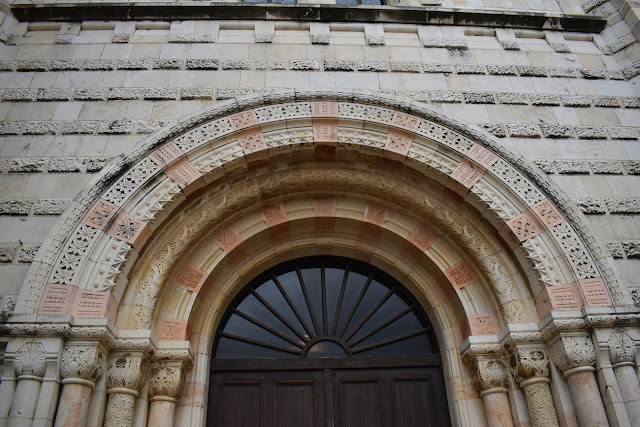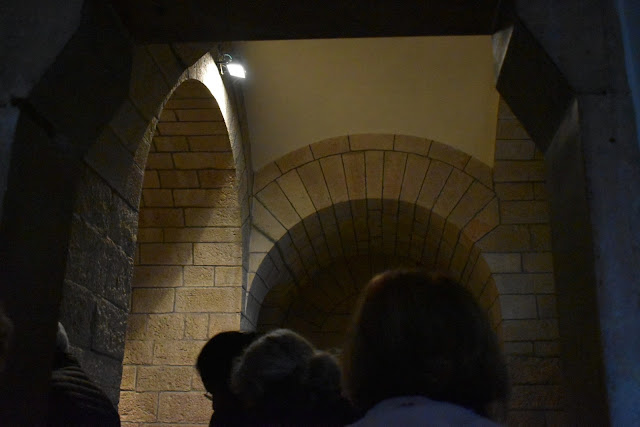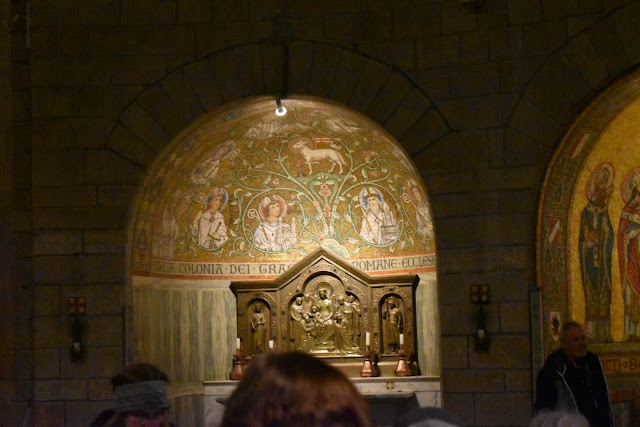After visiting the Upper Room, we continued on to the Church of the Dormition of Mary. It's practically next door. In fact, we passed by this church on the way, and it's seen from the outside in the second photo from the Upper Room posting. I didn't realize it at the time. It's the very round building in that post.
Christianity maintained accounts of the end of the life of Mary that varied a bit, but maintained certain key details in common. This was maintained through the Great Schism when the Catholic and Orthodox Churches split. But when Protestantism split, there was decreased focus on Mary, in some cases to such an extent that anything that would place her in a place of honor seemed to be rejected.
The Biblical account in Revelation of heaven speaks of souls in heaven. Although souls can refer to either the immaterial part of who we are, it can also refer to whole persons, such as when there's a plane crash and they report the number of souls onboard. But the vision of heaven spoke of souls when referring to most people, and spoke of the woman who gave birth to the Savior as having body parts. It's clear that this person is bodily in heaven. We know the early Christians cared a great deal about Mary. Unlike the Apostles, of whom we have relics of their bone fragments, there are no such relics of Mary. We know where Apostles like Peter are buried, but there is no tomb of Mary with a body. Extra-biblical accounts also point to the assumption of Mary into heaven, similar to how Elijah was taken up. Her assumption is different than the ascension of Jesus. Jesus ascended as only God can, as God brings people into heaven. Thus, it's not of her own power that she would reach heaven.
As my description of Gethsemane points out, there's a cave that I'd like to visit in the future. That cave is next to a site that the Orthodox would maintain as the Tomb of Mary. Here is where accounts may differ. It's referred to as "dormition" because Mary fell asleep. Sleep could refer to simply being in a state of normal nightly sleep as one is about to be brought bodily into heaven. But another interpretation is more like the rest in peace, where sleep could refer to death. Some argue that without experiencing sin, Mary had no reason to die, since death is the result of sin. But there's also a legend/account of her wanting to unite with the experiences of others by experiencing death. From what I understand, the Orthodox account would have her dying, being buried in that tomb, and then being assumed into heaven on the third day to partially parallel the death and ascension of Jesus.
 |
| Ceiling in the Basement of the Church of the Dormition |
Some trees go out on a limb to grow around here.
This tower is also seen in the site where the Upper Room is. So this photo with the entrance to this church on the left edge aims to show the very close proximity.Here is the sign outside the site.
This is the front of the church.
Whoa...look at the detailed carvings to form the arches. This is the kind of detail I remembered from the Church of Transfiguration on Mount Tabor.
Even the pillars are ornate.
Let's head inside. This is inside, not far from the entry.
This area wasn't very well lit, and it showed more of that solid stone forming the arches.
The floor was rather ornate as well. This is just the beginning when it comes to the floor.
We spent a little time on the main level, but I felt a bit rushed to capture images before we went downstairs to the level where Mary would have been. I would end up with more time to take photos on this main level later. So these are at angles that aren't the best.
This is between the main altar and that last photo. You can even see a little of it in the prior photo.


To the left of that one...
And to the left of that one...
Sometimes I made intentional attempts to photograph transitions. I knew this was when we went downstairs because I took a photo of the spiral staircase down. It's nice to know it was fancier than some others were. But it also tells me of the transition of location.
This was my first glimpse of what awaited in the lower level. The ceiling really stands out, since it has so much reflective gold and artwork. But below that is a effigy of Mary resting.
Here is the effigy in the center of the lower level. It's a rather simple form.
I took several photos of the ceiling above her, since it wasn't a very high ceiling for how broad it was, so it was hard to photograph it all at once. It also allows you to track a little bit with the relative locations of the items when you see the perspective shifts in the ceiling. So expect some alternation in ceiling and items located around the perimeter of the room. So I'm keeping these photos in the order I took them, rather than grouping like I used to do in many prior posts of other sites. Also, I mostly took photos of these things without getting too much depth of knowledge of what each one tried to depict.
This seems to depict events common to the lives of Mary and Jesus. It looks like the Annunciation account from Luke 1, then the Nativity scene, then what I assume is the ascension of Jesus, the Pentecost, and the Assumption of Mary. Then there's the crucifixion at the bottom with Mary at the side of Jesus.
Here's another depiction of the crucifixion.
Mary, with Jesus on her lap. She holds the scepter and forms a throne for Jesus.
This is the same area stepping back a bit.
This photo shows more of the many columns that hold up the church above. These also limited the perspectives I could use to take photos. But the columns looked very solid.
This looks like Pentecost to me...a dove representing the Holy Spirit, the color red, the streams of fire coming down upon the Apostles.
The center of these works of art shows the Black Madonna.
There is one chamber that's empty. That doesn't stop me from taking a photo of it. They usually mean something by empty spaces. Sometimes it's so we can imagine ourselves playing a part in doing God's will. Sometimes it's just to reserve space for more additions in the future. This is not meant as a bench for sitting.
Our Lady of Guadalupe is also present in the form of this replica of the miraculous tilma image.
Back to the effigy.
This is an artistic depiction of the dormition of Mary.
I zoomed in a bit on this view of the ceiling. I noticed that they aligned things properly. I'm at the head of Mary in this shot. So if the effigy was really her in a sleeping state and if she opened her eyes, she would see her Son (at least this image of Him).
Zooming out, one sees the ceiling, the last work of art that I captured (which was why the photos of the ceiling looked like Jesus was upside-down a moment ago).
This next photo makes it clear that I'm back upstairs. I captured that perspective I wanted form the lower level and had seen all I thought I'd see. I wanted to get a chance to take better shots of the main level. So here is the main altar area again.
The left-most imagery to the left of the altar...
Just to the right of that image...
This is a zoomed in version of what is at the bottom of that last photo.
This is just to the right of that area and just to the left of the altar.
Whoa! Here's that floor without so many feet and legs in the way.
I couldn't capture the entire floor. But I saw this as I moved closer to the exit (if I remember correctly).
This was just to the right of the altar.
And to the right of that...
And to the right of that...this wasn't in the earlier photos. I didn't have a good view of this at all before.
There's a pipe organ in this church.
The windows have the traditional blue and white colors that represent Mary. Although we don't have relics of her body, I have seen and been in the presence of a relic of her clothing. It also pairs up well with the way Luke 1 makes strong parallels between the Ark of the Old Covenant and Mary as the Ark of the New Covenant. Whenever the Ark was transported in public, it was draped with a blue cloth. That's not the only parallel, but the blue in the windows reminds me of that particular detail.
This ends our time in this place of rest.
We continued on to Gallicantu
That won't sound familiar to most people. But that is the site where Peter denied Jesus three times, and where Jesus was initially put on trial from one of the religious authorities...and then imprisoned.
















































Comments
Post a Comment